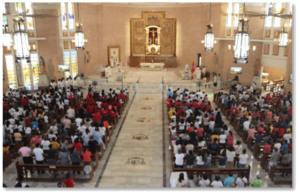Journey of Healing: Culion Island’s Leper Colony and the Pursuit of Cure
Civil Governor Luke Wright issued Executive Order No. 35 on August 22, 1905, naming the island the “Culion Leper Colony Reservation.” This
enabled Heiser, who was promoted to Director of Health that year, to start building there. As construction began in Culion, Filipino politicians openly opposed segregating the lepers, doubting that segregation would exterminate the disease, and arguing that construction and maintenance—which would be highly expensive—would be shouldered by the Philippine treasury, not by the Americans. Despite opposition and constant delays, the leper colony was completed by 1906.

“Culion Island: A Leper Colony’s 100-Year Journey Toward Healing,” a book published by the Culion Foundation, Inc. and Fundacion ANESVAD, describes the colony’s support system:
The buildings included patients’ dormitories and quarters for 400 employees. There were streets and alleys, a theater, a town hall, a school, a piped water supply and reservoirs, a sewer line, docks, warehouses, dining halls, a post office, a store, a garbage disposal plant, and the church was repaired.
Secretary of the Interior Dean C. Worcester issued a call for a Catholic chaplain for the colony. Volunteers from the Jesuit community elected to travel to Culion, ultimately replacing the Diocese of Jaro, which lacked priests. Along with the American Jesuits were four French nuns, the Sisters of St. Paul de Chartres, trained nurses who voyaged from France purposely to care for the lepers of the colony.
When the time came for the lepers to be whisked away to their “island paradise,” Heiser himself was on board the ship that carried 365 patients from Cebu. He remarked that the journey, albeit a jittery one on the crew’s part given the state of their human cargo, had been smooth sailing, arriving safely at Culion in 1906.
Heiser realized that simply grouping the patients together had solved the problem of distancing the disease; the next problem, however, lay in how this new society, into which the lepers had been thrust, would function. He need not have worried: over time the lepers had begun to form new friendships with one another in their new community. Slowly, they had gotten used to the warm touch of another human being, which they cherished without fearing the spread of their shared ailment. Nevertheless, the longing for their families left behind grew stronger overtime.
They also had very limited freedom, did not have the right to marry, and should they bear children, the babes had to be taken away six months after being nursed by their mothers, in hopes the infants would not contract the disease. The question had arisen as to whether or not leprosy is hereditary, but only later did conclusive studies find that fortunately, that was not the case.
But for now, their home would continue to be the Culion Sanitarium Hospital, the island’s leprosarium. For many decades, this was how daily life operated, with the lepers cut off from the outside world, while more assiduously than ever, medical teams continued the search for leprosy’s cure.

Sovereign Military Hospitaller Order of St John of Jerusalem of Rhodes and of Malta
1120 R. Hidalgo Street, Manila, Philippines Tel. +287080860 | orderofmaltaphilippines@gmail.com

